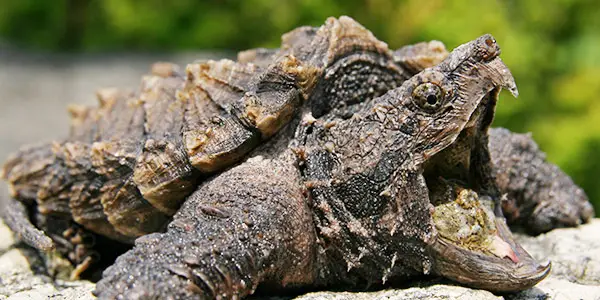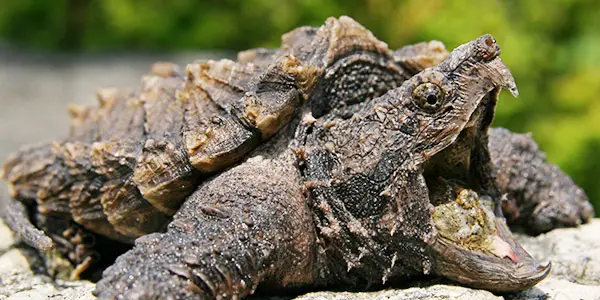The alligator snapping turtle is one of the largest freshwater turtles in the world. With its prehistoric appearance and powerful jaws, this species has long been a fascinating creature for animal enthusiasts. However, with the increase in habitat loss, pollution, and hunting, the alligator snapping turtle’s survival is now under threat, raising the question: are alligator snapping turtles endangered?
Despite their formidable size and appearance, these turtles are vulnerable to many dangers. In this article, we’ll explore the factors threatening the alligator snapping turtle population, the efforts being made to protect them, and what we can do to help ensure their survival in the future.
Yes, Alligator Snapping Turtles are considered endangered species. Their populations have declined due to habitat destruction, hunting, and pollution. These turtles can live up to 100 years and are found in the southeastern United States. Conservation efforts are being made to protect and conserve their populations.

Are Alligator Snapping Turtles Endangered?
Alligator snapping turtles are one of the most fascinating creatures in the world. They are the largest freshwater turtles in North America, and they have a unique appearance and behavior that make them stand out from other turtle species. These turtles are known for their strong jaws, which can crush almost anything that comes in their way. However, as impressive as these turtles are, they are also facing a significant threat from humans, and their population is declining rapidly. In this article, we will explore the question, are alligator snapping turtles endangered?
What are Alligator Snapping Turtles?
Alligator snapping turtles are a species of turtle that are native to the southeastern United States. These turtles are known for their large size, which can range from 80 to 220 pounds, and their distinctive appearance, which includes a spiked shell and a beak-like mouth. These turtles are also known for their unique hunting behavior, which involves lying motionless in the water with their mouths open, waiting for prey to come close enough to be snapped up by their powerful jaws.
Alligator snapping turtles are primarily found in rivers, lakes, and other freshwater habitats. They prefer slow-moving water with a lot of vegetation, which provides cover and shelter for them. These turtles are also known for their longevity, with some individuals living up to 100 years in the wild.
Threats to Alligator Snapping Turtles
Despite their impressive size and strength, alligator snapping turtles are facing a significant threat from humans. The primary cause of the decline in their population is habitat loss, which occurs when wetlands and other freshwater habitats are destroyed or degraded. This loss of habitat makes it difficult for these turtles to find food and shelter, and it can also make them more vulnerable to predators and other threats.
Another significant threat to alligator snapping turtles is hunting. These turtles have been hunted for their meat and shells for centuries, and this has led to a significant decline in their population. Although hunting is now illegal in many states, it still occurs illegally, and the demand for these turtles in the pet trade also contributes to their decline.
Endangered Status of Alligator Snapping Turtles
Alligator snapping turtles are currently listed as a threatened species under the Endangered Species Act. This means that they are at risk of becoming endangered in the near future if action is not taken to protect them. The decline in their population is a cause for concern, and there are several efforts underway to conserve and protect these turtles.
One of the most significant conservation efforts for alligator snapping turtles is habitat restoration. This involves restoring wetlands and other freshwater habitats that have been degraded or destroyed, providing these turtles with the food and shelter they need to survive. Other efforts include establishing protected areas for these turtles, enforcing hunting and poaching laws, and raising public awareness about the importance of conserving these unique creatures.
Benefits of Protecting Alligator Snapping Turtles
Protecting alligator snapping turtles is not only important for the survival of this species, but it also has significant benefits for the environment and other wildlife. These turtles play a crucial role in maintaining the ecological balance of freshwater habitats, and their decline can have far-reaching effects on other species that depend on these habitats for survival.
Protecting alligator snapping turtles can also have economic benefits. These turtles are a popular attraction for tourists and can contribute to local economies through ecotourism. Additionally, conserving these turtles can help maintain the ecological services that freshwater habitats provide, such as water filtration and flood control.
Alligator Snapping Turtles vs. Common Snapping Turtles
Alligator snapping turtles are often confused with common snapping turtles, which are a much more widespread species of turtle. Although both species have similar appearances and behaviors, there are some significant differences between them.
Alligator snapping turtles are much larger than common snapping turtles, with a more pronounced beak and a spiked shell. They also have a unique hunting behavior that involves lying motionless in the water with their mouths open, while common snapping turtles are more active hunters.
In terms of habitat, alligator snapping turtles prefer slow-moving water with a lot of vegetation, while common snapping turtles are more adaptable and can be found in a wide range of freshwater habitats.
Conclusion
Alligator snapping turtles are a unique and fascinating species of turtle that are facing significant threats from humans. Habitat loss and hunting are the primary causes of their decline, but there are several efforts underway to conserve and protect these turtles. Protecting alligator snapping turtles is not only important for their survival, but it also has significant benefits for the environment and other wildlife. By raising public awareness about the importance of conserving these turtles and taking action to protect them, we can ensure that these fascinating creatures will continue to thrive in the wild for generations to come.
Frequently Asked Questions
What is the Alligator Snapping Turtle?
The Alligator Snapping Turtle is a freshwater turtle that is native to the southeastern region of the United States. It is the largest freshwater turtle in North America, with some individuals weighing over 200 pounds. The Alligator Snapping Turtle gets its name from its powerful jaws, which are capable of crushing almost anything that comes in their way.
Despite their intimidating appearance and powerful jaws, Alligator Snapping Turtles are not typically aggressive towards humans. They spend most of their time in the water, where they hunt for fish, frogs, and other aquatic animals.
What is the status of Alligator Snapping Turtles?
Alligator Snapping Turtles are classified as a threatened species by the International Union for Conservation of Nature (IUCN). They are also protected under the Endangered Species Act in the United States. This means that it is illegal to hunt, capture, or trade Alligator Snapping Turtles without a permit.
The population of Alligator Snapping Turtles has declined significantly due to habitat loss, over-harvesting, and pollution. While efforts are being made to protect and conserve the species, more needs to be done to ensure their survival in the wild.
Where do Alligator Snapping Turtles live?
Alligator Snapping Turtles are found in the southeastern region of the United States, primarily in the states of Texas, Oklahoma, Arkansas, Louisiana, Mississippi, Alabama, Georgia, and Florida. They prefer slow-moving rivers, swamps, and other freshwater habitats with plenty of vegetation and cover.
Alligator Snapping Turtles spend most of their time in the water, where they hunt for food and bask in the sun. They can also be found on land, especially during the breeding season, when females will leave the water to lay their eggs in a suitable location.
What do Alligator Snapping Turtles eat?
Alligator Snapping Turtles are opportunistic feeders and will eat almost anything that they can catch. Their diet consists mainly of fish, but they will also eat frogs, snakes, turtles, birds, and small mammals.
Alligator Snapping Turtles are ambush predators, which means that they wait patiently for their prey to come close before striking. They use their powerful jaws to crush the shells of their prey and swallow them whole.
What is being done to protect Alligator Snapping Turtles?
Several measures are being taken to protect Alligator Snapping Turtles and conserve their habitat. These include habitat restoration, captive breeding programs, and public education initiatives.
In addition, laws and regulations have been put in place to protect Alligator Snapping Turtles from hunting, capture, and trade. It is important for individuals to respect these laws and do their part to protect these amazing creatures for future generations.
The BIGGEST TURTLES IVE EVER SEEN!? Alligator Snapping Turtles Move to Preserve
In conclusion, the alligator snapping turtle is indeed endangered. The population of this species has significantly decreased over the years, primarily due to habitat destruction, hunting, and illegal pet trade.
However, there is still hope for the alligator snapping turtle. Conservation efforts are underway to protect and preserve their natural habitat and reduce the impact of human activities on their population. It is crucial that we continue to raise awareness of their plight and take action to prevent their extinction.
Ultimately, the fate of the alligator snapping turtle rests in our hands. We must all do our part in protecting this magnificent species and ensure that it continues to thrive for generations to come.


